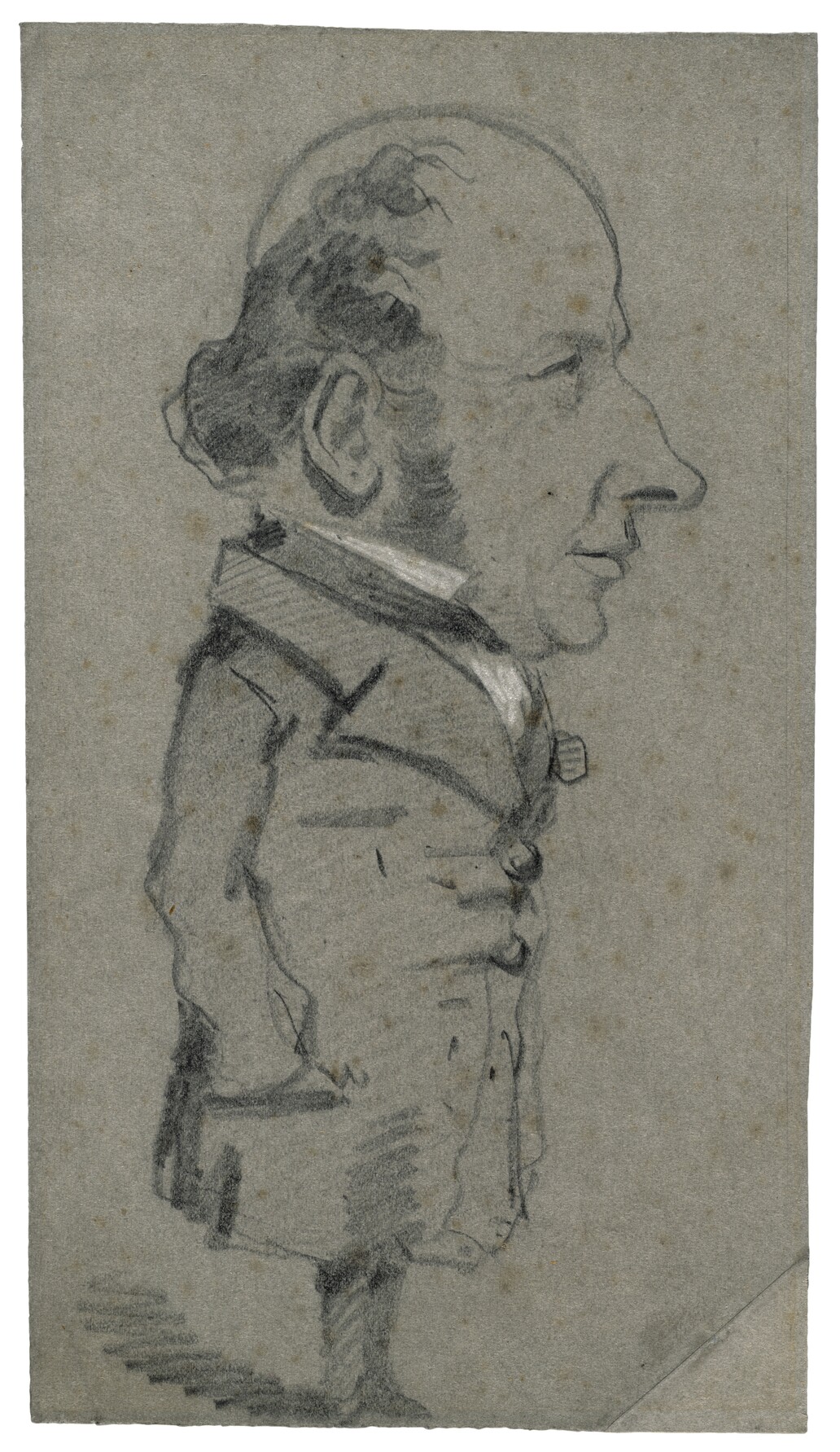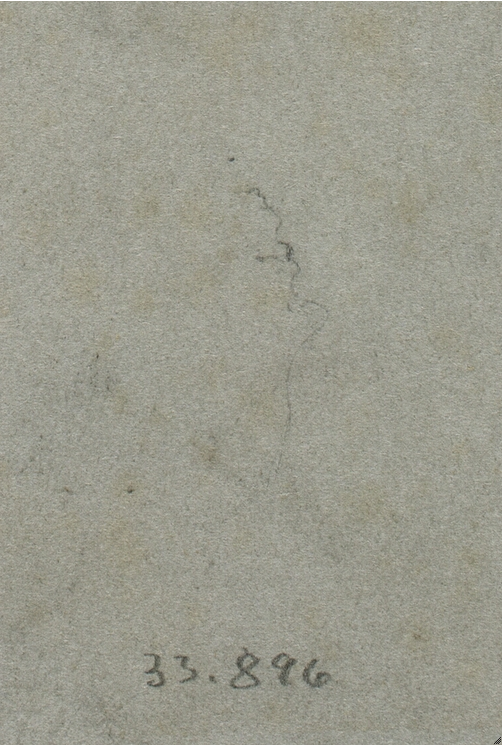Cat. 6
Caricature of Eugène Marcel
1855/56
Graphite, heightened with white chalk, on gray wove paper; 239 × 136 mm
The Art Institute of Chicago, Mr. and Mrs. Carter H. Harrison Collection, 1933.896
Technical Report
Technical Summary
Claude Monet created Caricature of Eugène Marcel using soft, broad [glossary:graphite] lines on a slightly textured, gray [glossary:wove] paper. The paper color serves as a middle tone for the composition. The artist worked out the figure with light, quick strokes of graphite, followed by darker, broader lines to more fully establish the form. Touches of white chalk were used to create the man’s shirt. The profile of the figure’s face remains sensitively rendered with fine graphite strokes.
Media and Support
Support Characteristics
Primary paper type
Gray, moderately thick, slightly textured wove paper.
Furnish
Uniform, with several wood and fiber inclusions.
Formation
Even.
Other characteristics
The edges are irregularly trimmed. The side and top edges are cut, while the bottom edge is torn as if along a straight edge or from a former binding, resulting in several small edge tears.
Dimensions
239 × 136 mm
Preparatory Layers
No artistic surface alterations or coatings are visible in normal conditions, under [glossary:UV] illumination, or under magnification. Under UV illumination, there is a pale-yellow visible-light [glossary:fluorescence] overall on the paper surface that is characteristic of a light gelatin surface [glossary:sizing].
Media Characteristics
The composition was drawn using the side of soft graphite to establish the outline and the form of the figure. Tonal effects were created using the side of the graphite in a back-and-forth motion to produce diagonal lines. There are a few areas of smudging of the graphite, although this appears to be offset rather than a result of the artist intentionally smudging the graphite. The point of the graphite was then used to further define the figure’s outline and to establish details. The artist used touches of white chalk to highlight certain areas, such as the collar and shirt of the figure.
There is a faint profile of a person in graphite on the verso (fig. 6.1).
Compositional Development
The composition was drawn directly onto the paper [glossary:support]. There is minor reworking at the top of the figure’s forehead, the tip of the nose, and the lips. The curvature of the figure’s forehead was reworked to create a more rounded head, and the tip of the nose was slightly lengthened and reinforced with a darker graphite line. In addition, the top lip was lengthened and extended out, while the bottom lip was redrawn slightly lower and shortened (fig. 6.2).
Surface Treatment
No fixatives or coatings are visible in normal conditions, under UV illumination, or under magnification.
Condition History
The drawing is in very good condition. There is light surface soiling and discoloration overall. Smudges from handling are evident at the upper right and lower right edges. Light discoloration is visible throughout, except along the very edges of the paper, which were protected from light exposure by a former window mat. Along the edges of the overall discoloration there is a faint brown [glossary:mat burn] line. There are many brown [glossary:foxing] spots throughout the sheet on the recto; there are no brown foxing spots visible on the verso. With UV-induced visible fluorescence, hundreds of foxing spots that are not visible in normal conditions fluoresce yellow. There is a faint, vertical graphite line along the right edge of the paper support. Under magnification, the paper fibers are slightly distorted and lifting. The lower right corner appears to be an old repair. The paper used to fill the loss may be of the same manufacture but is slightly lighter in tone. The edge of the repair slightly overlaps the original paper support, and it is reinforced on the verso with a white [glossary:Japanese paper] mend. The media are in good condition with no losses noted. Under magnification there are two small spots of black ink in the figure’s cheek and coat.
The drawing was treated in 2005 to reduce the appearance of the foxing spots on the recto. The old repair was maintained.
Dawn Jaros
Provenance
Alfred Dusseuil (1878–1927), Paris.
Sold by Henri Cottereau, Paris, to Carter H. Harrison (1860–1953), Chicago, winter 1927–28.
Given by Carter H. Harrison to the Art Institute of Chicago, 1933.
Selected References
Hugh Edwards, “The Caricatures of Claude Monet,” Bulletin of the Art Institute of Chicago 37, 1 (Jan. 1943), p. 71.
Charles Merrill Mount, Monet, a Biography (Simon & Schuster, 1966), p. 396.
Daniel Wildenstein, Claude Monet (Fratelli Fabbri, 1971), p. 91 (ill.), no. 44.
Rodolphe Walter, “Claude Monet as a Caricaturist: A Clandestine Apprenticeship,” trans. Eric Young, Apollo 103 (June 1976), p. 489.
Harold Joachim and Sandra Haller Olsen, French Drawings and Sketchbooks of the Nineteenth Century, vol. 2 (University of Chicago Press, 1979), p. 71, no. 4B6.
Daniel Wildenstein, Claude Monet: Catalogue raisonné, vol. 5, Supplément aux peintures: Dessins; Pastels; Index (Wildenstein Institute, 1991), p. 144, cat. D491 (ill.).
Other Documentation
Inscriptions and Distinguishing Marks
Verso
Mark
Location: lower right corner
Method: blue wax crayon
Content: X
Stamp
Location: center
Method: brown ink
Content: The Art / Institute of / Chicago
Mark
Location: center, bottom edge
Method: graphite
Content: 33.896
Examination Conditions and Technical Analysis
Raking Visible Light
Paper support characteristics identified.
Transmitted Visible Light
Paper mold characteristics identified.
Ultraviolet-Induced Visible Fluorescence (365 nm)
Light-yellow fluorescence observed throughout, along with hundreds of yellow fluorescing foxing spots.
Binocular Microscopy (80–100×)
Media type/application identified.
Image Inventory
The image inventory compiles records of all known images of the artwork on file in the Imaging Department and in the conservation and curatorial files in the Department of Prints and Drawings at the Art Institute of Chicago (fig. 6.3).



